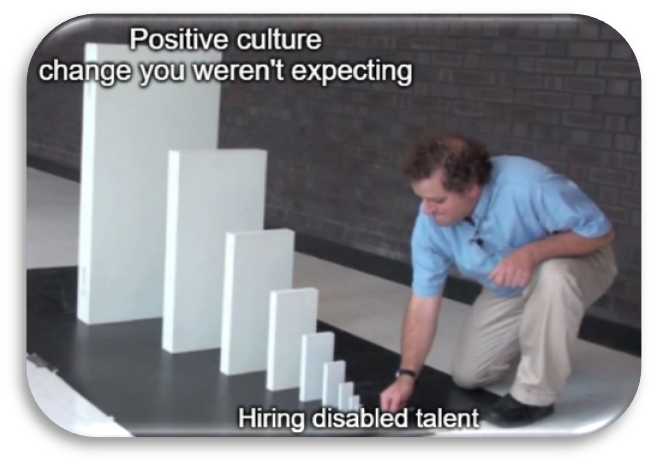The Ripple Effect of Disability Hiring
When companies commit to disability hiring, the impact often reaches far beyond the individual hire. It starts quietly. A new team member gets accommodations that help them perform more effectively. A manager communicates more clearly. Coworkers begin to see ability differently. People have a little more empathy and understanding.
…and just like that, a ripple starts moving through the organization.

The truth is, intended or not, disability hiring is a culture-shifting strategy. Whether you’re trying to improve engagement, support employee well-being, or strengthen retention, hiring autistic, neurodivergent and disabled perople can spark the exact kind of change you're looking for.
- People Start to Self-Identify—And That Changes Everything
You can’t support what you don’t know. When employees don’t feel safe to self-identify as having a disability, they often go without the tools or support they need to succeed. But that starts to shift when they see others being hired, included, and celebrated for their contributions.
Why this matters: Self-identification is a signal of trust. When people feel comfortable being themselves, they’re also more likely to speak up, ask for help, and participate fully in workplace culture.
How to encourage it:
- If you run self-ID campaigns, be transparent about why you collect this data and how it will be used.
- Promote confidentiality and ensure your systems are accessible and safe.
- Share real stories of employees who have self-identified and benefited from doing so.
2. Culture Becomes More Adaptive, Open, and Human
Disability hiring challenges your organization to think differently…and that’s a good thing. When you bring in people who process information differently, who communicate in unique ways, or who have creative ways of completing tasks, it forces your systems to evolve.
What improves:
- Teams become more thoughtful in how they collaborate.
- Leaders learn to manage strengths, not limitations.
- The stigma around asking for help decreases.
The result: You build a workplace that works better—for everyone.
Pro Tip: Small adaptations made for one person often end up benefiting the whole team. That’s the “curb-cut effect” in action—what starts as accommodation becomes best practice.
3. Continuous Learning Stops Being Optional
Disability hiring creates momentum for learning—because it highlights where your policies, systems, or assumptions still need work. And once that door is open, most teams want to walk through it.
How learning shows up:
- Managers request training on accessibility or inclusive communication.
- HR leaders start rethinking job descriptions and hiring processes.
- Employees begin asking deeper questions—not out of obligation, but out of curiosity.
Why this matters: Teams that embrace learning don’t just adapt—they get better over time. They create space for innovation and develop a workplace where flexibility is a strength, not a burden.
Final Thought
The ripple effect of disability hiring isn’t something you’ll always see in a spreadsheet. But you’ll feel it. In the conversations people have. In the confidence employees show. In the way your teams connect, grow, and support one another.
If you’re only measuring success by the number of hires, you’re missing the bigger story. Because the real impact of disability hiring shows up in culture—and culture is what drives performance, retention, and purpose.

